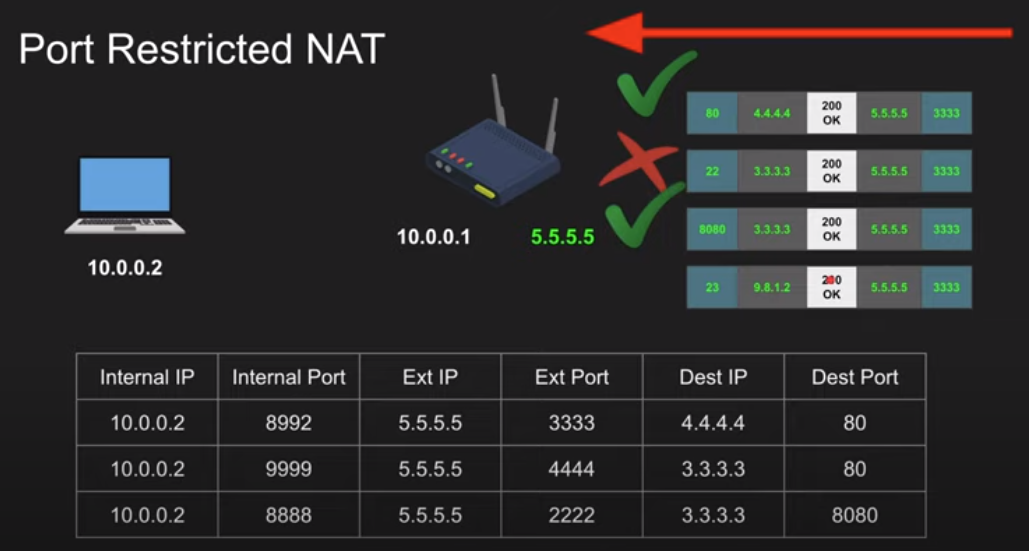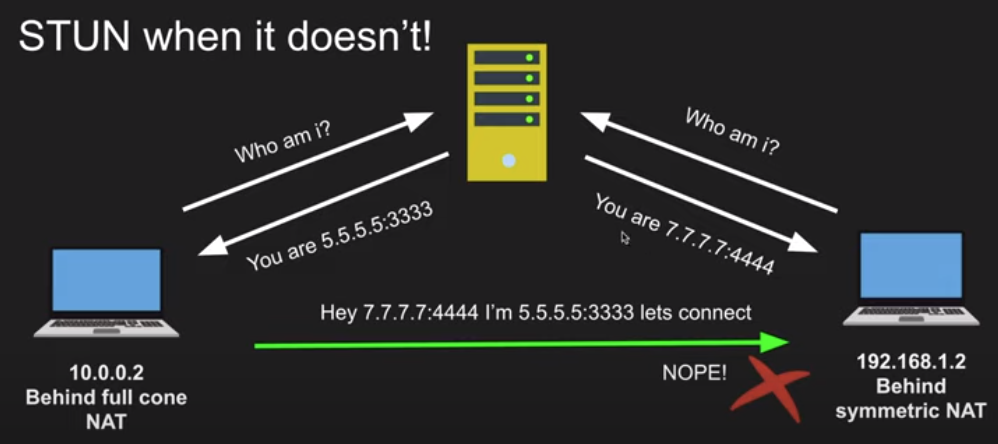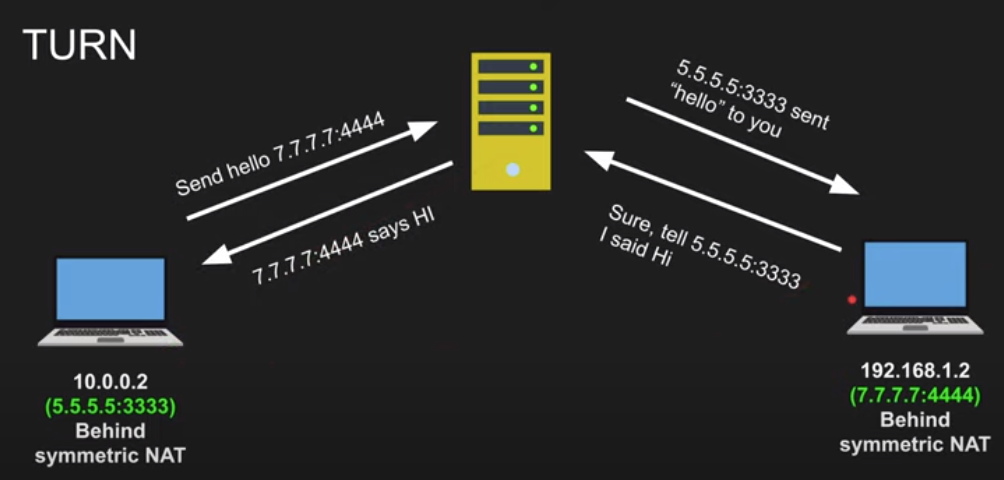-
Notifications
You must be signed in to change notification settings - Fork 3
WebRTC
it's a low latency API to exchange video and audio in an efficient manner which will enable rich direct peer to peercommunicaton between clients
in the process of connecting 2 peers we need signaling to communicate session information with each other (like whatsapp QR, HTTP fetch, WebSocket connection and ...) and after signaling is done , 2 peers can connect together via most optimal path
-
A wants to connect to B
-
A create ICE and put it with other options into SDP
-
A signals offer somehow to B
-
B create it's own SDP
-
B signals offer to A
-
connection is created
almost every device on internet is behind a NAT, means your are using a router (gateway) and your router's IP will communicate with world-wide-web, means first your device search for your requested IP address (you google sth and domain-name-server get you acual IP ), then your device search that if requested IP is under the same
subnetbut if not, then it will request to the router to transer request packet to requested IP web-server (in the process of transering, the router will create a table which iclude internal nd exernal IP & Port which will be replcaed via the router as requester)

-
One to One NAT (Full-cone NAT)
- packets to external IP:Port on the router always maps to internal IP:Port without exception

-
Address restricted NAT
-
packets to external IP:Port on the router always maps to internal IP:Port as long as source address from packet matches the table (regardless of port)
-
allow if we commnicated with this before

-
-
Port restricted NAT
-
packets to external IP:Port on the router always maps to internal IP:Port as long as source address and port from packet matches the table
-
allow if we commnicated with this host:port before

-
-
symetric NAT
-
packets to external IP:Port on the router always maps to internal IP:Port as long as source address and port from packet matches the table
-
allow if the full pair match (it's for you and me)

-
it's a remote server which will return your public ip address
tell me my public ip address:port throgh NAT (cheap to maintain)
- port 3478, 5349 for TLS

-
works for first 3 models of NAT translations (not symetric)

-
how clients behind Address/port restricted can connect to each other? The trick is they will try to communicate both with a dummy packet which will be blocked by each recipient (because no ip/port mapping ) exist but the second packet will pass because each device will see that they attempted to connect to the other one so packets will be allowed
-
why can't symmetric NAT use this technique as well? because the External Port is changed on each request.
-
when stun doesn't work

it's a server that just relays packets (expensive to maintain)
-
in case of suymetric NAT we use TURN: You would create a connection with a TURN server and tell all peers to send packets to the server which will then be forwarded to you. This obviously comes with some overhead so it is only used if there are no other alternatives.
-
port 3478, 5349 for TLS

it collects all available candidates (local IP addresses, reflexive addresses, STUN and TURN ones) whcih we call it
ice candicatesall the collected addresses are then sent to the remote peer via SDP
a format that describes ice candidates, networking, media, security and other options
it's not really a protocol, it's a format
-
most important concept in WebRTC
-
the goal is to take the SDP generated by a user and send it somehow to other party

a way to send SDP that we generated somehow to other party we wish communicate with
it can be done via tweet, QR code, WebSocket, HTTP request (DOESN'T MATTER, just send it to the other party)
in peer A (first browser):
const localConnection = new RTCPeerConnection()
// an event handler which specifies a function to be called when the icecandidate
// event occurs on an RTCPeerConnection instance
localConnection.onicecandidate = e => {
console.log(" NEW ice candidnat!! on localconnection reprinting SDP " )
console.log(JSON.stringify(localConnection.localDescription))
}
// Initiates the creation a new channel linked with the remote peer
const sendChannel = localConnection.createDataChannel("sendChannel");
sendChannel.onmessage =e => console.log("messsage received!!!" + e.data )
sendChannel.onopen = e => console.log("open!!!!");
sendChannel.onclose =e => console.log("closed!!!!!!");
// Initiates the creation of an SDP offer for the purpose of starting a
// new WebRTC connection to a remote peer
localConnection.createOffer().then(o => localConnection.setLocalDescription(o) )in peer B:
const offer = // sdp offer from peer A
const remoteConnection = new RTCPeerConnection()
remoteConnection.onicecandidate = e => {
console.log(" NEW ice candidnat!! on localconnection reprinting SDP " )
console.log(JSON.stringify(remoteConnection.localDescription) )
}
remoteConnection.ondatachannel= e => {
const receiveChannel = e.channel;
receiveChannel.onmessage =e => console.log("messsage received!!!" + e.data )
receiveChannel.onopen = e => console.log("open!!!!");
receiveChannel.onclose =e => console.log("closed!!!!!!");
remoteConnection.channel = receiveChannel;
}
remoteConnection.setRemoteDescription(offer).then(a=>console.log("done"))
// create answer and send the answer to the client
// Initiates the creation an SDP answer to an offer received from a remote peer during
// the offer/answer negotiation of a WebRTC connection
await remoteConnection.createAnswer().then(a => remoteConnection.setLocalDescription(a)).then(a=>
console.log(JSON.stringify(remoteConnection.localDescription)))in peer A:
const answer = // sdp offer from peer B
localConnection.setRemoteDescription(answer)-
from A:
sendChannel.send("hi peer B")
-
from B:
remoteConnection.channel.send("hi peer A")